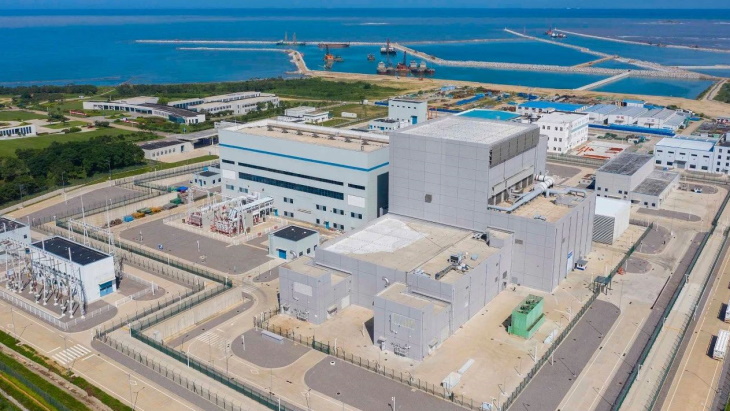Turbine tests completed at China's HTR-PM
Testing of the steam turbine using non-nuclear steam has been completed at the demonstration high-temperature gas-cooled reactor plant (HTR-PM) at Shidaowan, in China's Shandong province. The twin-unit HTR-PM is scheduled to start operations later this year.

The HTR-PM demonstration project at Shidaowan (Image: China Huaneng)
Non-nuclear steam flushing is an important test for nuclear power projects to check the operating quality of steam turbine units and conventional island systems prior to start up. The test verifies the design, manufacturing and installation quality of the steam turbine set.
The steam turbine of the HTR-PM reached operational speed using non-nuclear steam at 8.30pm on 14 August, China Huaneng announced today. It said all parameters, such as power and temperature, attained good standards; the main protection parameters were normal; and the auxiliary engine system operated stably.
Pressurised water reactor (PWR) nuclear power plants usually use the nuclear island primary circuit main pumps to generate heat, and use the secondary side of the steam generator to generate saturated steam as a steam source for testing the steam turbines. However, due to its gas-cooling characteristics and the structure of the steam generator, the HTR-PM could not perform non-nuclear flushing in accordance with the usual PWR test method. Instead, a "superheater" was employed to generate the steam.
Construction of the demonstration HTR-PM plant - which features two small reactors that will drive a single 210 MWe turbine - began in December 2012. Helium gas will be used as the primary circuit coolant. China Huaneng is the lead organisation in the consortium to build the demonstration units (with a 47.5% stake), together with China National Nuclear Corporation subsidiary China Nuclear Engineering Corporation (CNEC) (32.5%) and Tsinghua University's Institute of Nuclear and New Energy Technology (20%), which is the research and development leader. Chinergy, a joint venture of Tsinghua and CNEC, is the main contractor for the nuclear island.
Cold functional tests - which aim to verify the reactor's primary loop system and equipment as well as the strength and tightness of its auxiliary pipelines under pressure higher than the design pressure - were completed at the HTR-PM's two reactors on 19 October and 3 November last year, respectively. Cold functional tests at other types of reactors use water, while those at the HTR-PM used compressed air and a small amount of helium as the test medium.
Tests that simulate the temperatures and pressures which the reactor systems will be subjected to during normal operation started in January. Hot functional tests involve increasing the temperature of the reactor coolant system and carrying out comprehensive tests to ensure that coolant circuits and safety systems are operating as they should. Carried out before the loading of nuclear fuel, such testing simulates the thermal working conditions of the power plant and verifies that nuclear island and conventional equipment and systems meet design requirements.
A further 18 such HTR-PM units are proposed for the Shidaowan site. Beyond HTR-PM, China proposes a scaled-up version called HTR-PM600, which sees one large turbine rated at 650 MWe driven by some six HTR-PM reactor units. Feasibility studies on HTR-PM600 deployment are under way for Sanmen, Zhejiang province; Ruijin, Jiangxi province; Xiapu and Wan'an, in Fujian province; and Bai'an, Guangdong province.
Researched and written by World Nuclear News
- China Institute of Atomic Energy
- Nuclear Power Institute of China
- Southwestern Institute of Physics
- China Nuclear Power Operation Technology Corporation, Ltd.
- China Nuclear Power Engineering Co., Ltd.
- China Institute for Radiation Protection
- Beijing Research Institute of Uranium Geology (BRIUG)
- China Institute of Nuclear Industry Strategy (CINIS)
- China Nuclear Mining Science and Technology Corporation


